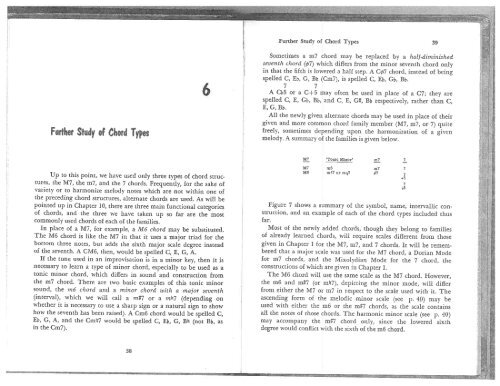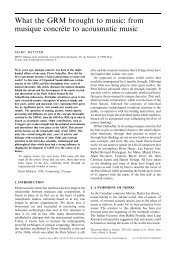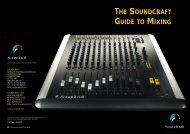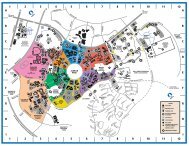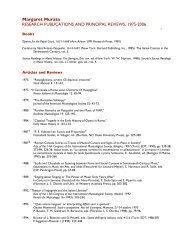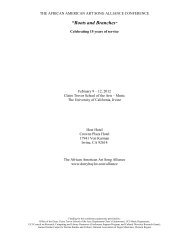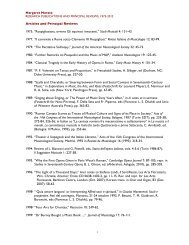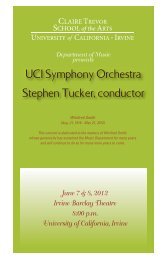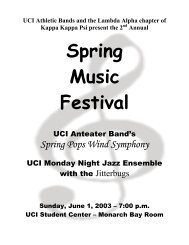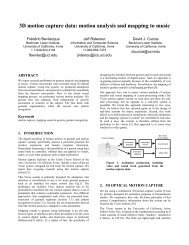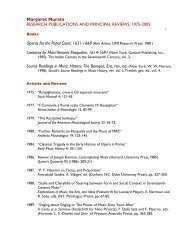Create successful ePaper yourself
Turn your PDF publications into a flip-book with our unique Google optimized e-Paper software.
Further Study of Chord Types<br />
Up to this point, we have used only three types of chord struc<br />
tures, the M7, the m7, and the 7 chords. Frequently, for the sake of<br />
variety or to harmonize melody notes which are not within one of<br />
the preceding chord structures, alternate chords are used. As will be<br />
pointed up in Chapter 10, there are three main functional categories<br />
of chords, and the three we have taken up so far are the most<br />
commonly used chords of each of the families.<br />
In place of a M7, for example, a M6 chord may be substituted.<br />
The M6 chord is like the M7 in that it uses a major triad for the<br />
bottom three notes, but adds the sixth major scale degree instead<br />
of the seventh. A CM6, then, would be spelled C, E, 0, A.<br />
If the tune used in an improvisation is in a minor key, then it is<br />
necessary to learn a type of minor chord, especially to be used as a<br />
tonic minor chord, which differs in sound and construction from<br />
the m7 chord. There are two basic examples of this tonic minor<br />
sound, the m6 chord and a minor chord with a major seventh<br />
(interval), which we will call a mfl7 or a mb7 (depending on<br />
whether it is necessary to use a sharp sign or a natural sign to show<br />
how the seventh has been raised). A Cm6 chord would be spelled C,<br />
El,, 0, A, and the Cmb7 would be spelled C, El,, 0, Th (not Bb, as<br />
in the Cm7).<br />
38<br />
Further Study of Chord Types 39<br />
Sometimes a m7 chord may be replaced <strong>by</strong> a half-diminished<br />
seventh chord (07) which differs from the minor seventh chord only<br />
in that the fifth is lowered a half step. A CØ7 chord, instead of being<br />
spelled C, El,, 0, Rb (Cm7), is spelled C, El,, Gb, Rb.<br />
7 7<br />
A Cb5 or a C+5 may often be used in place of a C7; they are<br />
spelled C, E, Gb, Rb, and C, E, G#, Rb respectively, rather than C,<br />
E, 0, Rb.<br />
All the newly given alternate chords may be used in place of their<br />
given and more common chord family member (M7, m7, or 7) quite<br />
freely, sometimes depending upon the hanuonization of a given<br />
melody. A summary of the families is given below.<br />
~!1 Tonic Minor’ rni<br />
M7<br />
MG<br />
inS<br />
m~7orm~7<br />
in?<br />
d7<br />
7<br />
+5<br />
7<br />
65<br />
Figure 7 shows a summary of the symbol, name, intervallic con<br />
struction, and an example of each of the chord types included thus<br />
far.<br />
Most of the newly added chords, though they belong to families<br />
of already learned chords, will require scales different from those<br />
given in Chapter 1 for the M7, m7, and 7 chords. It will be remem<br />
bered that a major scale was used for the M7 chord, a Dorian Mode<br />
for m7 chords, and the Mixolydian Mode for the 7 chord, the<br />
constructions of which are given in Chapter 1.<br />
The M6 chord will use the same scale as the M7 chord. However,<br />
the m6 and m$7 (or mb7), depicting the minor mode, will differ<br />
from either the M7 or m7 in respect to the scale used with it. The<br />
ascending form of the melodic minor scale (see p. 4P) may be<br />
used with either the m6 or the mI~7 chords, as the scale contains<br />
all the notes of those chords. The harmonic minor scale (see p. 40)<br />
may accompany the mfl chord only, since the lowered sixth<br />
degree would conflict with the sixth of the m6 chord.
Further Study of Chord Types<br />
V<br />
0 —<br />
V S —<br />
Cm6 cmbl<br />
C melodic minor scale (ascending)<br />
C harmonic minor scale<br />
C,n~7<br />
The scale which best fits the ~7 chord is one which uses the notes<br />
of a major scale of a half step up (called Locrian mode), hence<br />
a scale on B would use the notes of a C major scale, but starting on B<br />
(B, C, D, E, F, 6, A, B). This type of scale contains all the notes of<br />
a ~7 chord built on the root of the scale.<br />
V 0V<br />
cdv<br />
Locrian Mode on C (Db major scale, starting on C)<br />
7 7<br />
One appropriate scale fits both the +5 and b5 chords—the wholetone<br />
scale, which, as its title suggests, is constructed <strong>by</strong> using suc<br />
cessive whole steps only.<br />
V S — -<br />
FIGuRE 7 C whole-tone scale<br />
c2 ci,~<br />
.1•1 ~
Further Study of Chord Types 42<br />
A summary of all the types of chords, their families, and their<br />
accompanying scales is given below for quick reference.<br />
Chord<br />
Family Chord Scale<br />
M7 (Tonic Major) M7 Major Scale<br />
MG Major Scale<br />
Tonic Minor m6 Ascending Melodic Minor Scale<br />
m~7 Ascending Melodic or Harmonic<br />
Minor Scales<br />
m7 m7 Dorian Mode*<br />
07 Locrian Mode<br />
7 (Dominant) 7 Mixolydian Mode<br />
7<br />
+5 Whole Tone Scale<br />
7<br />
b5 Whole Tone Scale<br />
Jazz is a relatively new art whose language and symbols are still<br />
in the process of becoming standardized. Consequently, the student<br />
of improvisation could easily become confused <strong>by</strong> encountering<br />
unfamiliar symbols found in chord progressions given him <strong>by</strong> play<br />
ers of another geographical location. Some of the deviations one<br />
might expect to encounter are:<br />
M7 Maj.7, 47<br />
m7 7<br />
7 -7<br />
$7 mIS, —5<br />
MS 6<br />
7 x7<br />
Figure 8 shows a new progression to the blues, this one in the<br />
minor mode and using some of the chords introduced in this<br />
chapter. This should be transposed for the various instruments<br />
* Traditional modal terminology is given because it is unnecessary to coin<br />
new terms for an old scale system.<br />
Further Study of Chord Types 43<br />
and used as a reference sheet for the next playing session. The<br />
scheduling of playing sessions from this point is left to your own<br />
discretion. There is no limit to the number of possible sessions, but<br />
one should be scheduled at least whenever there is new material to<br />
be assimilated.<br />
4 £<br />
cm6 Fm6 cm6<br />
~<br />
7<br />
c..5 Fm~7 (ascending melodic minor)<br />
11pflO~• {Ijj ,I...frs”’ 1.<br />
-4—91<br />
Cm~7 ( harmonic minor) 007<br />
44 ~ 1 1~jJ fr.,t1fr1”°I<br />
7<br />
G~5 cmkl (ascending melodic minor)<br />
p<br />
L_ —<br />
—<br />
— 0 -L<br />
-<br />
-<br />
~<br />
4<br />
FIGURE 8<br />
(•<br />
projects<br />
1. Write and practice (in arpeggiated form on the instrument) the<br />
77<br />
M6, m6, m*7, (or m~7), ~7, +5, b5 chords in all keys.<br />
2. Write the melodic minor, harmonic minor, Locrian Mode, and<br />
whole-tone scales in all keys. (There are only two whole-tone<br />
scales. You will find the others are all repetitions of one or the<br />
other.)<br />
8. Above each of the written scales, write the chord root and chord<br />
type which can be used in conjunction with the scale.<br />
4. Transpose to all keys and practice the following pattern of scales.<br />
Play continuously, stopping only for breath.


